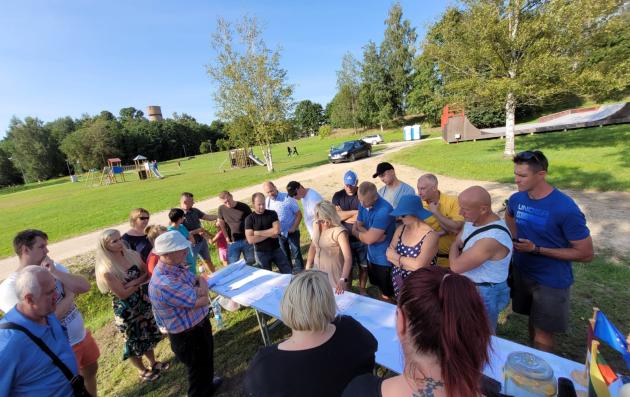Date of label : 29/10/2024
-
Saldus , Latvia
-
Size of city : 10.321 inhabitants

A group of people gathered outdoors in a park.
Summary
The city of Saldus (LV) is using experimental tools to target areas with planned or potential investments. These activities bring plans to life through involvement of stakeholders on relevant topics. The experimental tools include nature breakfasts, short hikes, mapping, and pop-up recreation spots. Over four years, the team concluded that this approach is effective in areas undergoing change or ones that need change. Pop-up activities incorporate public input enabling residents to anticipate and support new developments. These activities also foster a sense of belonging in the community.
The solutions offered by the Good Practice
One of the tools tested was participation in a hackathon. In 2021, the Saldus Municipality organised an online hackathon within the framework of the URBACT iPlace network to explore new ideas for making the city attractive for residents and new businessess alike. One team sought solutions for a plot of forest land located by Cieceres Lake, which is owned by the municipality but remains unused. The team, consisting of interested members, including landowners, entrepreneurs, residents, and young people, developed a thematic zoning plan and came up with "Ciecere Port", a public recreation area, which was piloted with the help of municipality staff with activities such as morning exercises, breakfasts, hikes, and concerts over a period of four weeks to gauge public interest and gather feedback.
As a result, a local company implemented two projects under European Agriculture Fund “Leader” programme, establishing a boathouse/café and a unique café. The area, which is now popular and accessible, demonstrates successful cooperation between the municipality and entrepreneurs.
The second pop-up experiment focused on municipal plans to develop an inner courtyard in the city centre. Through pop-up activities, the town engaged all participants—entrepreneurs, event organisers, NGOs, and the community—to test the space as a recreational area, generate ideas about its future use, and gather important feedback from the public to consider when implementing the final version of the project.
As a result, the municipality managed to transform the public’s initial scepticism about the green space into support for the project after people visited it throughout the summer and recognised its potential as a place to spend time and rest in the city centre.
Building on the sustainable and integrated urban approach
Saldus city’s participatory approach is evident in successful initiatives like the Lake area and the Pop-Up yard, where diverse stakeholders collaborated to shape urban development. When municipal specialists plan creatively and openly together, mutual respect grows, and the general mood improves.
By involving the community - those who use the space - through experimental means the municipality ensures more effective and useful outcomes. This approach has turned two pilot sites from sources of conflict into places of cooperation.
Based on participatory approach
Stakeholders involved:
Residents: Actively participate in pop-up events, feedback sessions, and community activities.
Local businesses: Engage in planning and development, as seen with the boathouse/ café project in Mežapark.
Municipal officials: Facilitate and coordinate activities, ensuring alignment with strategic goals.
Community organisations: Help organise events and mobilise residents.
Youth groups: Provide fresh perspectives and innovative ideas during hackathons and planning sessions.
Engagement activities include mechanisms for public feedback, and iterative planning. Regular updates provided by public-private partnerships ensure all parties are informed and involved.
This participatory approach results in projects that are better received by the public, more sustainable, and reflective of the community's collective vision.
What difference has it made?
The practice had a significant local impact, by using experimental activity sites to improve public understanding of municipal processes and plans.
Informal activities educate residents about local opportunities, foster a sense of belonging, and allow open dialogue between the municipality and residents, thereby humanising the institution and building trust.
Key outcomes:
- Community engagement: Continuous face-to-face engagement and targeted advertising increased attendance at events. Approximately 30% of the local population has actively participated in and benefited from these activities.
- Revitalised public spaces: Making spaces well-used and appreciated by the community.
- Insights gained: The activities helped the project team to understand the community’s needs and characteristics, and to optimise its communication strategies.
- Trust and support: The rising attendance at events reflected growing public interest and trust, and support for municipal projects.
Why this Good Practice should be transferred to other cities
This practice is highly applicable to other European cities, due to its focus on community engagement and inclusive decision-making. It addresses common urban challenges, such as public scepticism, lack of citizen involvement, and resistance to change.
The practice aligns with:
- Sustainable Development Goals (SDGs), including SDG 11 (Sustainable cities and communities), by promoting inclusive and sustainable urbanisation, and SDG 17 (Partnerships for the Goals).
- The Urban Agenda for the EU, by enhancing citizen participation and co-creating urban solutions.
- EU Territorial Agenda 2030.
The success of the Saldus region’s practice in transforming public spaces through inclusive activities and stakeholder collaboration can serve as a replicable model for other cities aiming to achieve sustainable and community-driven urban development. The method is adaptable and can be applied to any city, region, or community.
The key project features to transfer and customise:
- Involve residents, businesses, and community organisations from the start.
- Adapt activities to local contexts and needs.
- Foster strong public-private partnerships.
- Use digital and in-person channels for continuous feedback and updates.
- Ensure municipal support and alignment with strategic urban development goals.
- In-depth narratives of experience-sharing that highlight not just the outcomes but the process itself can be more motivating and beneficial.
The project team frequently shares its experiences with other Latvian cities, and via international project cooperation. It is recognised for its innovative public engagement activities in Latvia, and as local government specialists published a practical guide for establishing residents' councils, including best practices from the Saldus region.
